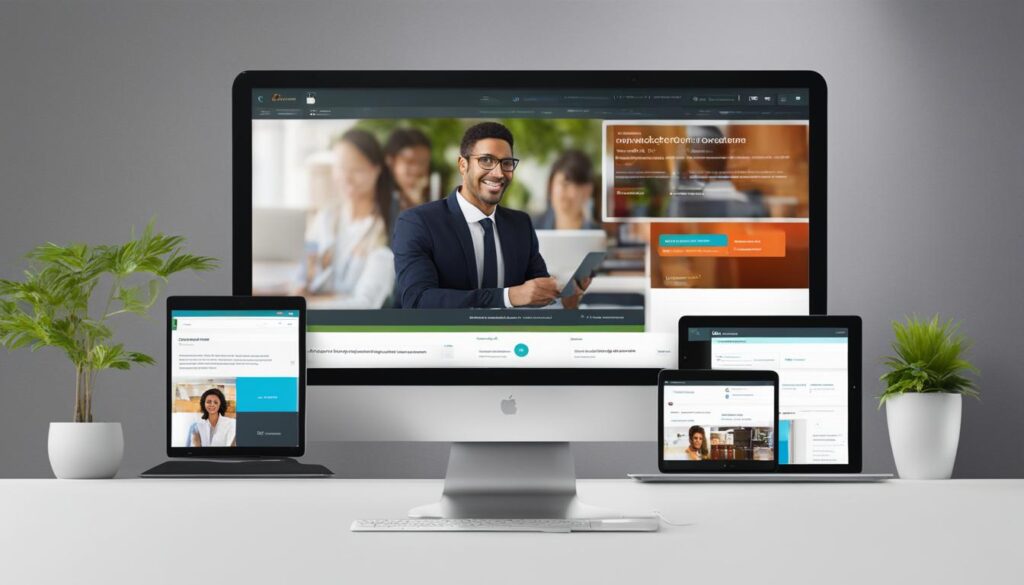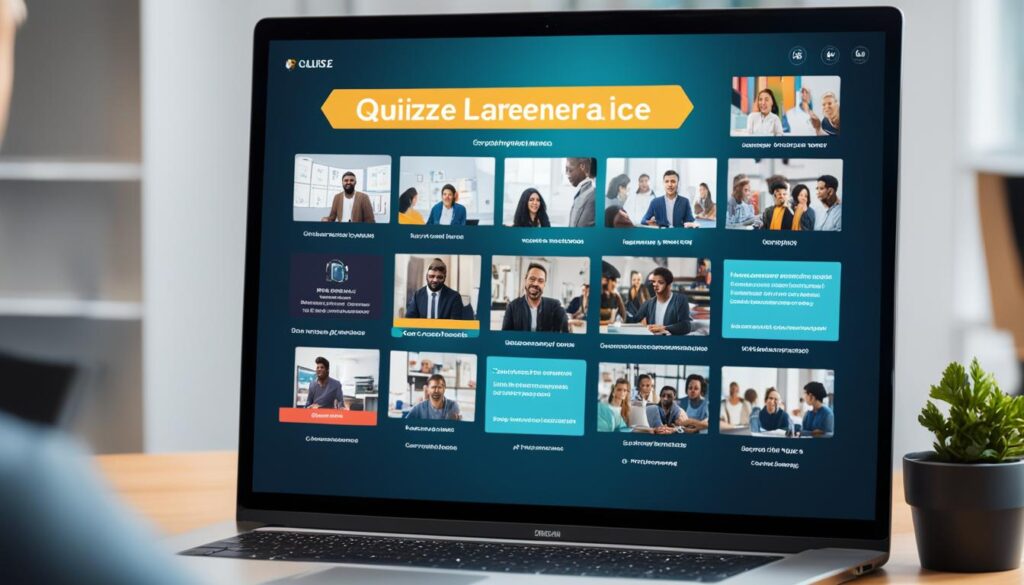Imagine possessing the power to impart knowledge and skills to people around the globe — without stepping out of your home. The era we live in makes this not just possible, but also practical, thanks to the rise of e-learning. Perhaps you’re keen on dipping your toes into the realm of online education, or maybe you’re looking to refine your craft in course development. In either case, your journey to excel in creating compelling online courses begins here. Armed with an in-depth understanding of instructional design and a toolkit for effective course content creation, you can construct educational experiences that resonate with learners everywhere. So, let’s dive into the strategies that will set your online courses apart and make a real impact in the digital learning space.
Key Takeaways
- Grasp the dynamics of e-learning to offer unparalleled flexibility and convenience to learners.
- Hone your skills in instructional design to craft courses that are both engaging and informative.
- Tap into the potential of online education by utilising modern techniques in course content creation.
- Embrace course development as a means to make high-quality education accessible to a global audience.
- Stay abreast of the latest trends and tools in the ever-evolving landscape of digital learning.
Understanding the Benefits of Online Courses
The landscape of education has shifted significantly, with online learning and distance learning emerging as pivotal components in modern education. As you explore the realm of virtual classrooms, it’s essential to recognise the comprehensive benefits brought forth by these digital platforms. Beyond the bounds of traditional education, these innovative learning methodologies offer several advantages that cater to a diverse learner demographic.
Flexibility for Learners
One of the most significant advantages of online courses is the flexibility they provide. With the demands of work and personal responsibilities, the conventional schedules of education institutions can be restrictive. Online learning platforms, as components of a robust learning management system, allow you to engage with course materials at your own pace, at times and places that fit into your lifestyle seamlessly. This adaptability not only fosters a balanced life but also eliminates the stress of scheduling conflicts.
Access to Global Expertise
Imagine having the opportunity to learn from the world’s leading experts without the need to travel. Online courses break down geographic barriers, offering you access to high-calibre educational content, often from prestigious universities and institutions. This global approach not only enriches the learning experience but also provides you with a broader perspective and a diverse set of skills that are highly valued in today’s interconnected world.
Cost-Effectiveness of Course Delivery
Financial considerations play a crucial role in education, and the cost-effectiveness of online courses is a benefit that cannot be overstated. The digital delivery of courses significantly reduces the need for physical learning materials, commuting expenses, and on-campus infrastructure. By minimising these overheads, education providers can pass on the savings to you, making education more accessible and affordable.
| Benefits | Online Learning | Traditional Learning |
|---|---|---|
| Flexibility | Study at your own pace, anytime, anywhere | Fixed schedules, location-bound |
| Expert Access | Global instructors, diverse content | Limited to local instructors |
| Cost Savings | Reduced material and commuting costs | Additional fees for resources and facilities |
The Role of Technology in Online Learning
The sweeping advancements in technology have significantly influenced the realm of education, transforming instructional design and enhancing the reach and quality of online learning. With the digital landscape continuously evolving, it’s your chance to harness these technologies to not only streamline the educational process but also to provide students with critical digital literacy skills.

Imagine creating immersive learning environments that are interactive, flexible, and accessible from anywhere in the world. The impact of such technologies is not subtle; they revolutionize the way knowledge is shared and consumed. No longer are you bounded by physical space or limited by resources – today’s technology has given birth to a limitless virtual classroom.
- Cloud-based platforms allow for seamless access to course materials and enable collaborative learning irrespective of geographical barriers.
- Learning Management Systems (LMS), such as Moodle and Blackboard, facilitate a highly organised instructional framework essential for delivering diverse course content.
- Interactive whiteboards and live-streaming services make real-time engagement and feedback possible, simulating traditional classroom dynamics.
In your quest to provide an exceptional online learning experience, it’s instrumental to integrate technology that not only imparts knowledge but also encourages students to develop proficiency in its use. Future-proofing education means preparing learners for a digital economy, and tech-based instructional design is at the heart of this mission. Embrace these tools and watch as your digital classroom becomes a springboard for innovation and success.
Key Elements of Effective Online Learning Platforms
As you navigate the sea of e-learning solutions, certain features stand out that can make your journey through education as smooth and rewarding as possible. A well-designed course platform can be the bridge to success, connecting educators and learners in a dynamic and intuitive environment. Let’s delve into the aspects that elevate a learning management system from good to great.
User-Friendly Design
User experience in e-learning is paramount. A platform with a user-friendly design encourages active participation and can significantly reduce the time it takes for both teachers and students to adapt to the system. This includes clear navigation, accessible content and streamlined processes that facilitate an environment where learning becomes the focus, rather than struggling with the interface.
Responsive and Adaptive Learning Environments
In today’s fast-paced world, the ability of a course platform to adjust to varied devices is non-negotiable. A responsive design means that whether you’re on a desktop, tablet, or smartphone, the learning management system provides a consistent experience. Additionally, an adaptive learning environment tailors the learning path to the pace and style of the individual, enhancing the personalisation of education.
Analytics and Reporting Tools
Insight is the key to continuous improvement in e-learning. Advanced analytics and reporting tools offer a holistic view of learner progress, engagement levels, and areas for enhancement. This data empowers educators to refine their approach and learners to understand their performance, ensuring the learning objectives are being met effectively.
| Feature | Benefit to Educators | Benefit to Learners |
|---|---|---|
| User-Friendly Design | Simplified content creation and course management | Effortless navigation and material access |
| Responsive Design | Consistent teaching experience across devices | Flexible learning accessible on any device |
| Adaptive Learning Environment | Ability to personalise student learning paths | Customised education that fits individual needs |
| Analytics | Detailed feedback for course improvement | Insights into performance to boost progress |

By prioritising these key features in your selection, you can ensure that the e-learning environment you choose not only meets but exceeds the educational goals of all involved. An effective learning management system is not just a repository of knowledge but a thriving, interactive community that fosters the pursuit of lifelong learning.
Creating Engaging and Interactive Course Content
As the online education sphere expands, the focus on creating course content that captivates and educates is paramount. It’s about blending instructional design with creativity to foster an environment where every learner thrives. Before diving into the specifics, understand that course content creation is not just about imparting knowledge, but also about weaving an experience that resonates with diverse learners.
Incorporating Multimedia Elements
Embracing a multitude of multimedia elements is essential in crafting a course that is not just informative but also engaging. From video lectures that bring concepts to life to interactive quizzes that test understanding in real time, the tools at your disposal are varied and powerful. But it’s the strategic integration of these tools that will set your course apart.

Consider the inclusion of audio components that reinforce learning, particularly beneficial for auditory learners. To complement, visual aids such as infographics can simplify complex data, making it digestible for those who learn best through images and diagrams. The key is to create a balanced mix of media that caters to a broad audience while keeping your content aligned with the core objectives of the course.
Designing for Different Learning Styles
Your audience is diverse, and so should your content. The principles of instructional design suggest we consider all learning styles during course content creation. This not only ensures inclusivity but also maximises the potential for student success in the realm of online education.
- Visual learning: integrating charts, maps, and videos.
- Auditory learning: incorporating podcasts, discussions, and narrations.
- Kinesthetic learning: using simulations and interactive activities.
Below is a table illustrating methods to match content with different learning modalities:
| Learning Style | Content-Type | Tools and Techniques |
|---|---|---|
| Visual | Images, Diagrams, and Videos | Infographics, Mind Maps, Animation |
| Auditory | Lectures, Discussions, Audio Books | Podcasts, Recorded Interviews, Storytelling |
| Kinesthetic | Interactive Sessions, Hands-on Labs | Virtual Reality, Interactive Simulations, Role-playing Games |
The table showcases that a thoughtful approach to online education can encompass a variety of methods to engage learners fully. Your task as an instructional designer is to craft these experiences so that they’re not only rich in quality but also accessible and enjoyable for all your students.
Strategies for Effective Course Development
Embarking on course development requires a deep understanding of instructional design, ensuring the final product is not only educational but highly engaging. Crafting effective online courses is akin to building a bridge—every component must be meticulously designed, from the initial foundation to the final touches that lead learners to their goals.
As you delve into the specifics of your course, consider incorporating these agile steps into your development strategy:
- Define your educational objectives
- Organise content to build progressively on knowledge
- Develop activities that encourage practical application
- Integrate assessments to gauge and reinforce learning
- Reflect on feedback to refine the course iteratively
This structured approach to course development ensures each piece fits perfectly, creating an overarching learning experience that’s both comprehensive and comprehensible.
Let’s not forget the essential checklist that could be pivotal in enhancing your course’s quality:
| Phase of Development | Action Items | Impact on Learning |
|---|---|---|
| Initial Planning | Setting SMART goals, audience analysis | Aligns course with learner needs & objectives |
| Design and Layout | Storyboarding, wireframing, and prototyping | Creates an intuitive and navigable course structure |
| Content Creation | Writing, recording, and editing educational materials | Produces engaging and understandable content |
| Feedback Loop | Pilot testing, surveys, and expert reviews | Ensures content accuracy and addresses learner pain points |
| Final Implementation | Launch and continuous monitoring for improvements | Maintains course relevance and effectiveness over time |
Remember, excellent instructional design isn’t just about what you teach; it’s also how you present it. By designing your content to accommodate diverse learning styles and factoring in the opportunity for real-world application, you’re set to deliver a course that not only educates but truly resonates with your audience.
Best Practices for Instructional Design in E-Learning
Within the realm of e-learning, the art and science of instructional design are paramount to delivering effective education. As you dive into the world of online course content creation, understanding these best practices will ensure your instructional materials meet high standards of educational excellence.
Aligning Objectives with Content
To cultivate a successful e-learning environment, your course objectives must be woven into the very fabric of your instructional design. It’s about creating harmony between what you aim to teach and how you plan to present it. Let’s explore strategies for aligning your learning objectives with the course content you develop:
- Begin with the end in mind by establishing clear learning outcomes.
- Design each piece of content, be it a lecture, reading assignment, or interactive activity, to contribute towards the specified goals.
- Ensure assessments accurately measure the acquisition of knowledge as per the stated objectives.
Applying Learning Theories and Models
Integrating established learning theories and models into your course content creation bolsters the effectiveness of your instructional design. Here’s a glance at some of the theories and models that should be at the forefront of your strategy:
| Learning Theory/Model | Description | Application in E-Learning |
|---|---|---|
| Constructivism | Knowledge is constructed through experience and reflection. | Facilitate active learning by providing real-world problems for learners to solve. |
| ADDIE Model | A systematic instructional design model with five phases: Analyse, Design, Develop, Implement, and Evaluate. | Employ an iterative process for designing e-learning courses, ensuring a structured and thorough approach. |
| Blooms Taxonomy | A framework for categorising educational goals by complexity. | Create content that encourages higher-order thinking as learners progress through the taxonomy’s levels. |
By applying these best practices in instructional design and e-learning, you are poised to create courses that are not only information-rich but also genuinely conducive to learning. Remember, your primary objective is to foster an environment where learners can flourish, mastering the material you have so thoughtfully designed.
Tips for Supporting Students in a Virtual Classroom
As an educator in the realm of online learning, your role extends beyond delivering content. It’s about fostering a virtual classroom where every student feels supported and geared for success. In this space, the learning management system becomes an extension of the physical classroom, providing a plethora of tools to uphold the essence of traditional teaching in a digital environment.
Establishing Clear Communication Channels
Communication is the lifeblood of effective online teaching. Creating an environment where students feel comfortable to reach out and contribute is essential. Utilise the various features of your learning management system to encourage openness and dialogue. Direct messaging, forums, and announcements play crucial roles in keeping everyone in the loop. Always remember, clear and consistent communication helps in building a strong learning community, driving engagement and participation among students.
Providing Timely Feedback and Assessments
Your feedback is a powerful tool that shapes the learning journey of your students. Timely and constructive feedback encourages learners to reflect on their understanding and strive for improvement. Combining regular assessments within your learning management system offers a structured approach to gauge their progress, allowing you to tailor your support to each student’s needs. Below is a comprehensive table illustrating various assessment methods and the feedback approach suitable for a virtual classroom.
| Assessment Method | Type of Feedback | Tools |
|---|---|---|
| Quizzes | Instant Automated Feedback | Quiz Modules in LMS |
| Peer-reviewed Assignments | Peer Feedback | Discussion Boards, Review Portals |
| Personal Projects | One-on-One Feedback | Video Conferencing, Messaging Systems |
| Participation | Continuous Direct Feedback | Live Chat Rooms, Virtual Classrooms |
Promoting and Marketing Your Online Courses
As you delve into the realm of e-learning, it’s essential to recognise the importance of a well-crafted promotional strategy for your online courses. In the digital space, a robust online course marketing plan is not just desirable—it’s indispensable for reaching your target audience and driving enrollments. Start by leveraging the power of social media, a bustling marketplace of ideas and conversations where your courses can gain substantial traction.
Enhancing your online presence through a solid course platform is another key strategy. Intuitive design coupled with SEO optimisation ensures your courses are easily discoverable by potential learners using search engines. But don’t stop there—creativity in your email campaigns can also heighten interest, creating a buzz around your offerings. Webinars serve as a brilliant avenue not only for direct engagement but also for demonstrating the immediate value and expertise that your courses provide.
Forming partnerships can be a game-changer in broadening the reach of your courses. By collaborating with established entities within the e-learning community, you tap into new networks and gain an endorsement that can enhance your credibility. Remember, the market is crowded, and standing out requires a blend of strategic planning, engaging content, and persistent effort. It’s your mission to convey the unique selling points of your courses in every piece of marketing content you produce, ultimately influencing learners to opt for your online educational resources.
FAQ
What are the benefits of creating online courses?
Online courses offer several advantages, including the flexibility for learners to study on their schedule, access to a global range of expertise, cost-effectiveness in delivery, and the elimination of geographical barriers. They also allow for personalized learning experiences and can accommodate a diverse range of learning styles. Furthermore, online courses can reduce costs associated with physical classrooms and widen access to education.
How has technology transformed online learning?
Technology has been a game changer in e-learning, enabling the creation and distribution of diverse and interactive content. It allows for sophisticated instructional design, adaptive learning experiences, and efficient tracking of student progress through analytics and reporting. Technological advancements also support the acquisition of digital skills that are vital in the modern workforce.
What makes an online learning platform effective?
An effective online learning platform should be user-friendly, offering an intuitive design that is easy to navigate. It needs to be responsive and adapt to different devices and learning styles. Additionally, it should provide robust analytics and reporting tools that can help educators monitor student progress and tailor the learning experience accordingly.
How can instructional design improve the efficacy of online courses?
Instructional design plays a critical role in structuring effective online courses by aligning educational objectives with course content. Implementing established learning theories and models, such as the ADDIE model or constructivist approaches, can significantly enhance the learning process, ensuring that each component of the course is contributing effectively to the educational goals.
What strategies can be employed to support students in a virtual classroom?
Supporting students in a virtual classroom involves establishing clear communication channels through tools like discussion boards, direct messaging, and virtual office hours. It is also essential to provide timely and constructive feedback, as well as regular assessments, to facilitate a reflective and comprehensive learning environment that helps students gauge their understanding and progress.
How can I market my online courses effectively?
Marketing your online courses effectively involves promoting them through various channels such as social media, email marketing, webinars, and partnerships. It’s important to harness the power of SEO to make your courses more discoverable online and to create compelling content that highlights the unique benefits and selling points of your educational offerings to attract more students.
Why is incorporating multimedia elements important in course content creation?
Incorporating multimedia elements such as video, audio, and interactive quizzes is crucial because it caters to different learning styles and keeps learners engaged. Multimedia can make content more accessible and interesting, leading to better retention of information and a more enjoyable learning experience.
In what ways should online course content be tailored to fit different learning styles?
Online course content should be designed with the recognition that learners absorb information differently. This means creating materials that appeal to visual, auditory, and kinesthetic learners by including a mix of text, images, videos, interactive simulations, and practical exercises. Matching content to these learning modalities ensures a more inclusive and effective educational experience.
What are the key steps in developing an online course?
The key steps in developing an online course include identifying your target audience, setting clear learning objectives, designing the course structure and content, and applying instructional design principles. It’s also essential to incorporate interactive elements, provide support mechanisms for learners, and continuously evaluate and update the course based on feedback and learning outcomes.





